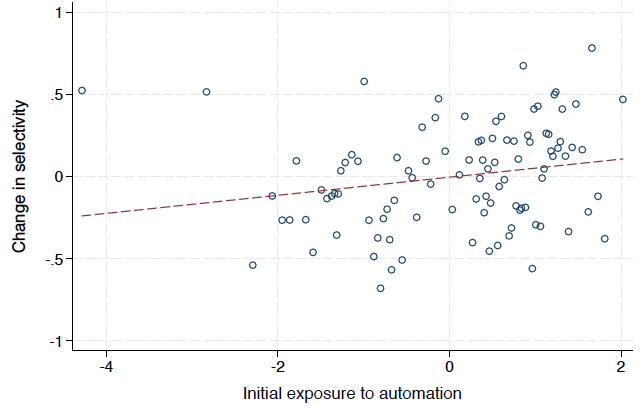Automation and offshoring are two contemporary trends that are perceived to have a disruptive impact on several aspects of the labour market, such as employment opportunities or wage inequality, and growth. Understanding their effects, their relative importance, and their possible interactions has been the focus of many influential papers (among many others Acemoglu and Restrepo 2020, Autor et al. 2013).
If we think of automation and offshoring as simply two different types of `technological change', standard neoclassical reasoning suggests that their effects will not be different from those of previous industrial revolutions. Any improvement in the state of technology leads to an increase in labour productivity. In turn, employment increases as labour demand cannot deviate from the long-run path dictated by the evolution of labour productivity. Concerns about the impact of new technologies can be rationalised only if one departs from the neoclassical paradigm in which any threat to wages and employment may come more from the impacts on the competitiveness of markets in the presence of frictions rather than from changes in the production function in the presence of frictionless markets (Caselli and Manning 2019).
In Faia et al. (2020) we hypothesise that beyond productivity effects, automation and offshoring fundamentally affects the matching between workers and firms. Firms need workers with heterogeneous skills to perform heterogeneous tasks. A match occurs when a firm meets and employs a worker with the appropriate skills. The ideal match delivers the maximum achievable productivity. The productivity of less-than-ideal matches decreases with the distance between the matched tasks (on the firm side) and skills (on the worker side). Matches between firms and workers are not necessarily ideal as search frictions make them less selective, i.e. willing to accept less-than-ideal matches. This is how search frictions induce ‘mismatch’ between tasks and skills, that is, divergence between the actual matches and the ideal ones.
Our key hypothesis is that better matches (i.e. matches that generate larger outputs for a given firm-worker pair) enjoy a comparative advantage in exploiting automation and a comparative disadvantage in exploiting offshoring. As such, automation will increase firms’ and workers’ selectivity, which in turn decreases mismatch and employment. Following the same logic, we predict that offshoring will increase employment by reducing selectivity.
Figure 1 gives a first indication on the interaction of automation and offshoring and their effect on employment using data from the European Labour Force Survey for 13 European countries. Occupations that had a higher probability of being automated (as measured by their routineness) in 1995 experienced a decrease (dashed line) in total hours worked in the subsequent years (1995-2010) as employment shifted from routine to non-routine occupations. This negative relationship is driven by highly offshorable occupations (solid black line), while the change in hours worked seems unrelated to the routine-intensity in low-offshorability occupations (solid grey line).
Figure 1 Automation, offshoring, and hours worked
The idea that automation increases the value of the ideal match by making skills and tasks more complementary is motivated by recent survey evidence (2018 Talent Shortage Survey by Manpower Group, 2018). This evidence highlights the increased prevalence of talent shortage with a growing number of jobs left unfilled because applicants are not talented enough for the job. Talent shortage is strongly linked to technology, but does not necessarily depend on a dearth of workers with higher education. Difficulties in recruiting the ‘right man for the job’ tend to be reported in manufacturing, ICT, and health care for jobs such as skilled trades workers, machine operators, sales representatives, engineers, technicians, ICT professionals, and office support staff (Cedefop Eurofound 2018). Machine operators, for instance, are required to have machine-specific experience ranging from the knowledge of production procedures to the ability to understand blueprints, schematics, and manuals. Due to technological change, they are also increasingly required to be familiar with different types of machines, each with its own specific blueprints, schematics, and manuals. A concern for both firms and workers is that retraining from a known to a new machine can be a costly time-consuming process, making them cautious about a potential mismatch.
If automation increases the productivity of ideal matches relative to less-than-ideal ones, it may, therefore, make firms and workers more willing to give up the surplus of a less-than-ideal match and instead wait for a better one. This increased selectivity improves the productive efficiency of matches that are eventually formed and better matches end up commanding a higher wage premium. The result is increased match efficiency together with more unemployment and wage inequality. The type of heterogeneity we have in mind is ‘horizontal’ rather than ‘vertical’ as usually assumed in the literature on skill-biased or routine-biased technological change. While these concepts are very relevant, our paper highlights additional effects of automation and offshoring at work independently from any vertical heterogeneity. As ideal matches are the ones that define firms’ and workers’ core competencies, we use ‘core-biased technological change’ to label the way technology evolves in our conceptual framework.
Differently, offshoring may increase the productivity of less-than-ideal matches relative to ideal ones by allowing firms to unbundle tasks into subtasks to be performed at home or abroad depending on comparative advantages. It may, therefore, make firms and home workers less selective. On the one hand, decreased selectivity reduces the productivity of ‘less-than-ideal’ matches that are eventually formed. On the other hand, match surplus may still increase thanks to specialisation according to comparative advantage. Hence, differently from automation, offshoring may lead not only to higher match productivity, but also to higher employment and less wage inequality.
When embedded in a quantitative model, these features imply that how automation and offshoring affect labour market outcomes depends on the interactions of four effects. Figure 2 displays simulation results of our model where higher automation (A) implies productivity increases due to more automation and higher Ω corresponds to the share of production that is offshored. While automation increases the productivity of any given match (‘productivity effect’), it also increases the relative productivity of ideal matches relative to less-than-ideal ones (‘mismatch effect’). In parallel, offshoring increases the productivity of any given match thanks to domestic workers’ subtask specialisation (‘specialisation effect’), while also decreasing the subset of subtasks assigned to them (‘substitution effect’). As productivity and specialisation effects of automation and offshoring increase the match surplus of domestic firms and workers, mismatch and substitution effects work in the opposite direction. These opposing forces create an inverted U-shaped function of employment in automation and offshoring: productivity and specialisation effects dominate when automation and offshoring are limited whereas mismatch and substitution effects dominate when automation and offshoring have already reached an advanced stage.
Whether our theoretical mechanism indeed operates in practice (i.e. whether the mismatch effect is strong enough to reverse the neoclassical conclusions) is in the end an empirical issue, which we investigate focusing on 92 occupations at the three-digit ISCO-88 level and 16 (out of 21) sectors according to the NACE Rev.2 classification from 13 European countries for the period 1995 – 2010.
Figure 2 Automation, offshoring, and employment (quantitative model)
We capture firms’ and workers’ match selectivity at the sector-occupation level. While a sector may cover a rich menu of occupations, these include a submenu of ‘core’ occupations that are disproportionately concentrated in the sector. In this respect, an increase in the concentration of occupations’ employment across sectors can be interpreted as an increase in match selectivity. We thus compute an index of selectivity (the ‘sectoral selectivity of occupations’) defined as the concentration of occupations’ employment across sectors. The index inversely measures the willingness of firms and workers to accept less-than-ideal matches. Figure 3 shows that selectivity rises in our sample period especially in occupations that are highly automatable.
Figure 3 Automation and selectivity
This suggestive evidence is confirmed in our econometric analysis. In line with our model we find that occupations with higher automatability become more selective. This effect is driven by occupations with above-median automatability while there is no impact on selectivity for occupations characterised by below-median automatability. We also find that sectors with higher initial offshorability experience a differential decrease in selectivity. Our results continue to hold when we use more standard selectivity measures borrowed from the literature, such as ‘skill mismatch’ and ‘unemployment duration’.
As our model predicts, we find a robust negative relationship between selectivity and employment at the occupation level. To address potential endogeneity concerns stemming from the fact that our measure of selectivity is calculated from occupation employment shares, we construct a Bartik instrument. The negative effect of selectivity on employment materialises especially in occupations with above-median automatability. Finally, by putting together the results on the impacts of automatability and offshorability on selectivity with those on the impact of selectivity on employment, we show that automation reduces (offshoring increases) employment through the selectivity channel of our framework.
Growing concerns about the negative impacts of automation and offshoring on employment and wage inequality are well documented. While traditional neoclassical arguments imply that those concerns are unfounded, a negative relation of employment and wage equality with improvements in technology arises naturally in our setting of ‘horizontal mismatch’ where search frictions hinder the efficient assortative matching between firms with heterogeneous tasks and workers with heterogeneous skills. Our analysis in terms of ‘core-biased’ change illustrates a more general idea of how wages and jobs in frictional labour markets may react to shocks beyond our application to technology and offshoring.
References
Acemoglu, D and P Restrepo (2020), “Robots and Jobs: Evidence from US labor markets”, Journal of Political Economy 128(6): 000–000
Autor, D H, D Dorn and G H Hanson (2013), “The Geography of Trade and Technology Shocks in the United States”, American Economic Review 103(3): 220–25.
Caselli, F and A Manning (2019), “Robot Arithmetic: New Technology and Wages”, American Economic Review: Insights 1(1): 1–12.
Cedefop Eurofound (2018), “Insights into skill shortages and skill mismatch: Learning from Cedefop’s European skills and jobs survey”, Cedefop Reference Series 106.
Faia, E, S Laffitte, M Mayer and G Ottaviano (2020), “Automation, Globalization and Vanishing Jobs: A Labor Market Sorting View”, CEPR Discussion Paper 14787
Frey, C B and M A Osborne (2013), “The Future of Employment: How Susceptible are Jobs to Computerization?”, Working Paper.
Manpower Group (2018), Solving the Talent Shortage: Build, Buy, Borrow and Bridge.










